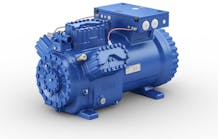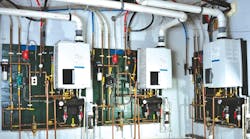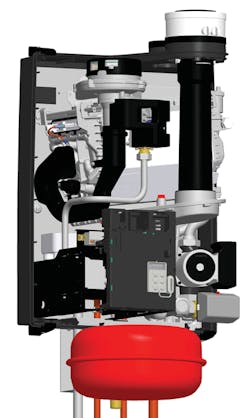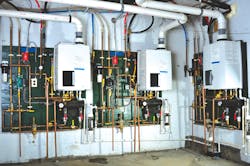For years, heating and water-heating options for multifamily developments were rather limited, with many building owners choosing traditional hot-water boilers for their applications. These boilers can be cumbersome, can take up valuable space, and can be inefficient in regard to energy consumption and hot-water delivery. This can lead to high utility bills and complaints from tenants about limited hot water, problems that can worsen as a boiler ages.
Just over a decade ago, a new heating/heating-and-water-heating option for multifamily dwellings arrived in North America: the high-efficiency wall-hung condensing boiler. A standard in Europe for many years, these units save space and reduce utility bills while continuously providing heat and hot water to tenants.
A Little Background
A condensing boiler achieves high energy efficiency by capturing latent heat from exhaust gases and using it to preheat incoming cold water. This high-percentage heat transfer leaves little heat to be expelled and lost through the vent system. As a result, exhaust-gas temperature falls below the dew point, causing water vapor in the exhaust to condense into liquid. These boilers typically are gas-fired and have an annual fuel-utilization efficiency (AFUE) of 90 percent or more. Their being small and light enough to be hung on walls, meanwhile, enables more efficient use of floor space.
Heating-only condensing boilers provide a closed-loop central-heating option. Heating-and-water-heating, or combi, boilers, meanwhile, are engineered with an open loop for domestic-hot-water output and a closed loop for central heating. Thus, they can serve as both a high-efficiency, on-demand water heater and a central heating system. By installing one combi boiler per apartment, owners can individualize utilities for tenants.
How They Work
High-efficiency condensing boilers operate similarly to condensing tankless water heaters. Condensing boilers, however, have one heat exchanger, while condensing tankless water heaters have two. Combi boilers have a stainless-steel flat-plate heat exchanger separating the central-heating water supply from the domestic-hot-water water supply.
Central-heating operations of a condensing boiler can be controlled via thermostat. Depending on how they are needed, thermostats can be wired either directly to a boiler or to external controls that communicate with the boiler. Upon a call for heat, a thermostat sends a signal directly to a boiler’s printed circuit board, which engages a circulator to begin moving water from the heating system into the boiler. For maximum heat transfer to be achieved, the water is preheated as it passes through the heat exchanger multiple times. At this point, the heat exchanger captures the resulting exhaust gases and transfers their latent heat to the water. The gases then cool and condense into water vapor, which is directed through a condensation trap into a drain.
Once a boiler has heated system water, the heat is delivered to heat emitters, such as panel radiators or baseboard panels.
Combi boilers heat water for domestic service through a similar process. Upon a call for hot water, demand is received by a flow switch adjacent to a combi boiler’s flat-plate heat exchanger. For domestic-hot-water service to begin, the flat-plate heat exchanger measures the temperature of the incoming water, as well as that of the water in the boiler loop, to calculate the amount of heat needed to deliver water at the desired temperature. When a specific delta-T is reached, the boiler knows domestic hot water is in use and gives it priority. Then, it sends a signal to the gas burner, instructing it to adjust its flame accordingly. A continuous supply of water heated to the desired temperature then is delivered to the user for as long as needed.
When the demand for domestic hot water or heating ends, the gas-control valve closes, and the boiler goes into standby mode until the next call for hot water or heat.
Benefits
Benefits of condensing boilers include:
Space savings. Wall-hung condensing boilers are smaller and lighter than traditional boilers. Not only do they take up less room and, because they are mounted on the wall, free up valuable floor space, they can be delivered through relatively small doorways. Space saving is maximized with combi boilers, which eliminate the need for separate heating and water-heating systems.
High energy efficiency/lower utility bills. Condensing boilers are more energy-efficient than traditional hot-water boilers and can significantly reduce utility bills for building owners and tenants. Traditional hot-water boilers of today have, on average, AFUE ratings of 80 percent, while condensing boilers can have AFUE ratings of up to 96 percent.
Individualized utilities. The energy efficiency and smaller size of wall-hung condensing boilers offers the opportunity to individualize utilities, with each apartment served by its own boiler and having its own thermostat. Boilers can be installed separately, inside each apartment, or grouped together in a central location, such as a building’s basement.
By individualizing, a building owner passes responsibility for utility use to each tenant and no longer has to pay the heating bill for the entire building. This can be a big selling point for tenants, as they can control the heat in their unit instead of having to accept the consensus offered by a central boiler system.
Prolonged equipment life. Some high-efficiency condensing boilers have down-fired ceramic burners that ensure any condensation in exhaust is captured quickly and diverted to a drain. In the bottom-up burner configurations of traditional boilers, any condensation in exhaust could make its way back into a unit and drop on the burner system or damage the heat exchanger.
Simplified installation and maintenance. Some combi boilers are designed with a low-loss header (LLH)—also known as a hydraulic separator—to help balance flow between the system loop and boiler loop. As an added benefit, the LLH replaces traditional primary-secondary piping, simplifying boiler installation and reducing labor and material costs.
Some LLH come with ball valves that isolate boilers, making maintenance significantly easier. Boiler isolation allows contractors to turn off water flow to and from a boiler quickly.
Conclusion
High-efficiency gas-fueled wall-hung condensing boilers provide a range of high-performance heating and water-heating options for the multifamily-housing industry. Today’s condensing boilers help decrease utility bills and keep renters happy through consistent heat and continuous hot water.
As a product manager for Rinnai America Corp., Tracy Young manages all heating products, including high-efficiency boilers and direct-vent wall furnaces. Also, he is responsible for overseeing related marketing collateral and research, Website content, certifications, and ENERGY STAR listings.
Did you find this article useful? Send comments and suggestions to Executive Editor Scott Arnold at [email protected].











